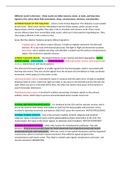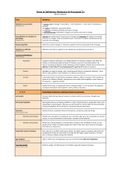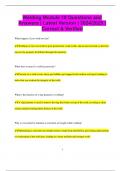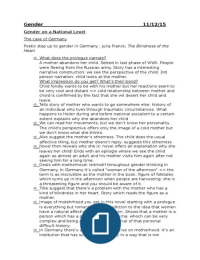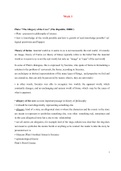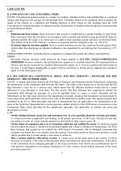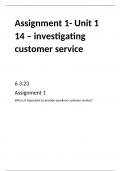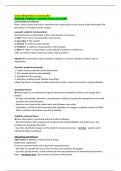Different nuclei in the brain – these nuclei are either sensory, motor, or both, and help relay
signals to the cortex about limb movements, sleep, consciousness, alertness, and attention.
ANTERIOR NUCLEI OF THE THALAMUS – what is in the frontal thalamus? The thalamus is surrounded
by the fornix. These nuclei receive information from the limbic system, which consists of the
hippocampus and the amygdala. They play a role in emotions and memory recall. These nuclei
receive afferent input from mammillary body nuclei, which are in the posterior hypothalamus. They
then project efferent to the cerebral cortex.
Areas that the anterior thalamus projects efferent signals to:
- Cingulate gyrus: sits above corpus collosum. It helps to regulate autonomic function and
memory. AF is any issue with internal processes, like fight or flight and hormonal secretion.
- Neocortex: role in spatial reasoning, and attention. Located near the primary somatosensory
region. Also involved in episodic memory.
LATERAL THALAMIC NUCLEI – The largest thalamic nuclei. Ventral and dorsal segregation. Ventral
anterior nucleus, ventral lateral, and ventral posterior. Medial geniculate nucleus, lateral geniculate
nucleus, lateral dorsal, and lateral posterior.
The VAN and VLN work together to modify signals from the basal ganglia, which is associated with
learning and reward. They also receive signals from the striatum and cerebellum to help coordinate
movement, which projects to the motor cortex.
Lateral geniculate nucleus is involved in vision. It connects with the optic nerve. It helps to establish
between fields of vision, where the right eye helps to see items in the left field and the left eyes the
right. When one eye is in the dark all the time, the other eye retains more axons in this nucleus to
assert monocular dominance.
Medial geniculate nucleus is involved in auditory processing. It projects signals to the primary
auditory cortex, which helps to process and understand where sounds came from.
VENTRAL ANTERIOR THALAMIC NUCLEI – it is bordered by the VLN and the reticular nucleus, which
lies on the anterior VAN. Relays information to and from the basal ganglia and premotor cortex.
Involved in planning movement and balance; DOES NOT cause the movement. MOTOR PROCESSING
VENTRAL LATERAL NUCLEUS – Pars oralis and pars caudalis. Anterior subgroup and posterior
subgroup. Deep contralateral nuclei and the global pallidus project information to the VLN. The
nuclei project this input to the motor regions to stimulate motor feedback. MOTOR MOVEMENT
VENTRAL POSTERIOR NUCLEUS – Main relay nucleus for somatosensory pathways. Two sub-
divisions. Ventral posteromedial (input for facial movement from trigeminal nerve) and ventral
posterolateral (pain and temperature). Afferents come in from spinal interactions and the trigeminal
cranial nerve, which is involved in facial movement. Then efferent signals project to the
somatosensory and insular cortex. They help to maintain pain signals, temperature, joint pain, and
muscle movement. SENSATIONS.
signals to the cortex about limb movements, sleep, consciousness, alertness, and attention.
ANTERIOR NUCLEI OF THE THALAMUS – what is in the frontal thalamus? The thalamus is surrounded
by the fornix. These nuclei receive information from the limbic system, which consists of the
hippocampus and the amygdala. They play a role in emotions and memory recall. These nuclei
receive afferent input from mammillary body nuclei, which are in the posterior hypothalamus. They
then project efferent to the cerebral cortex.
Areas that the anterior thalamus projects efferent signals to:
- Cingulate gyrus: sits above corpus collosum. It helps to regulate autonomic function and
memory. AF is any issue with internal processes, like fight or flight and hormonal secretion.
- Neocortex: role in spatial reasoning, and attention. Located near the primary somatosensory
region. Also involved in episodic memory.
LATERAL THALAMIC NUCLEI – The largest thalamic nuclei. Ventral and dorsal segregation. Ventral
anterior nucleus, ventral lateral, and ventral posterior. Medial geniculate nucleus, lateral geniculate
nucleus, lateral dorsal, and lateral posterior.
The VAN and VLN work together to modify signals from the basal ganglia, which is associated with
learning and reward. They also receive signals from the striatum and cerebellum to help coordinate
movement, which projects to the motor cortex.
Lateral geniculate nucleus is involved in vision. It connects with the optic nerve. It helps to establish
between fields of vision, where the right eye helps to see items in the left field and the left eyes the
right. When one eye is in the dark all the time, the other eye retains more axons in this nucleus to
assert monocular dominance.
Medial geniculate nucleus is involved in auditory processing. It projects signals to the primary
auditory cortex, which helps to process and understand where sounds came from.
VENTRAL ANTERIOR THALAMIC NUCLEI – it is bordered by the VLN and the reticular nucleus, which
lies on the anterior VAN. Relays information to and from the basal ganglia and premotor cortex.
Involved in planning movement and balance; DOES NOT cause the movement. MOTOR PROCESSING
VENTRAL LATERAL NUCLEUS – Pars oralis and pars caudalis. Anterior subgroup and posterior
subgroup. Deep contralateral nuclei and the global pallidus project information to the VLN. The
nuclei project this input to the motor regions to stimulate motor feedback. MOTOR MOVEMENT
VENTRAL POSTERIOR NUCLEUS – Main relay nucleus for somatosensory pathways. Two sub-
divisions. Ventral posteromedial (input for facial movement from trigeminal nerve) and ventral
posterolateral (pain and temperature). Afferents come in from spinal interactions and the trigeminal
cranial nerve, which is involved in facial movement. Then efferent signals project to the
somatosensory and insular cortex. They help to maintain pain signals, temperature, joint pain, and
muscle movement. SENSATIONS.

